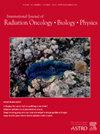StrataXRT and Mepitel Film for Preventing Postmastectomy Acute Radiation Dermatitis in Breast Cancer: An Intrapatient Noninferiority Randomized Clinical Trial
IF 6.5
1区 医学
Q1 ONCOLOGY
International Journal of Radiation Oncology Biology Physics
Pub Date : 2024-11-26
DOI:10.1016/j.ijrobp.2024.11.076
引用次数: 0
Abstract
Purpose
Acute radiation dermatitis (ARD) is a notable challenge for patients with breast cancer undergoing postmastectomy radiation therapy (RT). This study evaluates the efficacy, safety, and user experience of StrataXRT versus Mepitel Film for ARD prevention.
Methods and Materials
This multicenter, noninferiority trial involved intrapatient randomization of 44 patients with histologically confirmed breast carcinoma who had undergone postmastectomy RT across 4 Australian hospitals from January 1 to December 31, 2017. Patients were randomly assigned to receive Mepitel Film and StrataXRT on alternate halves of the irradiated chest wall. Mepitel Film was applied by nurses and replaced every 1 to 2 weeks or as necessary, ensuring continuous coverage throughout RT. Conversely, patients self-applied StrataXRT daily to the opposite half, with adherence details recorded in patient diaries. The primary outcome was the mean difference in the time-weighted average (TWA) grade of ARD within designated rectangles in each half over 10 weeks from the commencement of RT.
Results
Forty patients were analyzed per-protocol. Measurements using thermoluminescent dosimeters showed no significant dose differences between medial and lateral rectangles. StrataXRT was inferior to Mepitel Film in the primary outcome, with a mean difference in TWA grade of 0.19 (95% confidence interval, 0.12-0.26; P < .001). Secondary outcomes—mean difference in TWA grade in chest wall halves, worst ARD grade, and incidence of moist desquamation—showed noninferiority between treatments. Patient preferences were closely matched, with 37.5% favoring StrataXRT and 40% Mepitel Film. StrataXRT caused itching in 1 patient and Mepitel Film in 3, leading to 1 removal.
Conclusions
Although StrataXRT did not meet the noninferiority threshold in the primary outcome and is considered inferior, its ease of application and patient acceptance suggest that it may still be offered for ARD prevention in postmastectomy RT when Mepitel Film is not a practical option. Open discussion with patients and caregivers is recommended to determine the most appropriate skin protection agent, considering both efficacy and practicality.
StrataXRT和Mepitel膜预防乳腺癌乳房切除术后急性放射性皮炎:一项患者内非劣效性随机临床试验
目的:急性放射性皮炎(ARD)是乳腺癌患者接受乳房切除术后放射治疗(RT)的一个显著挑战。本研究评估了StrataXRT与Mepitel Film预防ARD的疗效、安全性和用户体验。方法:这项多中心、非劣效性试验纳入了2017年1月1日至12月31日在澳大利亚四家医院接受乳房切除术后RT治疗的44名组织学证实的乳腺癌患者的患者内随机分组。患者随机接受Mepitel Film和StrataXRT在照射的胸壁上交替进行。Mepitel Film由护士使用,每一到两周或必要时更换一次,确保整个治疗过程持续覆盖。相反,患者每天自行使用StrataXRT到另一侧,并在患者日记中记录遵守细节。主要转归是在随机对照试验开始后的10周内,每一半指定矩形内ARD的时间加权平均(TWA)等级的平均差异。结果:按方案分析了40例患者。使用热释光剂量计的测量显示,在内侧和外侧矩形之间没有显着的剂量差异。StrataXRT在主要结局上不如Mepitel Film, TWA等级的平均差异为0.19(95%可信区间:0.12-0.26;结论:尽管StrataXRT在主要结局中未达到非劣效性阈值,被认为是劣效性的,但其易于应用和患者接受程度表明,当Mepitel Film不能作为实际选择时,StrataXRT仍可用于乳房切除术后RT预防ARD。建议与患者和护理人员进行公开讨论,以确定最合适的皮肤保护剂,同时考虑疗效和实用性。
本文章由计算机程序翻译,如有差异,请以英文原文为准。
求助全文
约1分钟内获得全文
求助全文
来源期刊
CiteScore
11.00
自引率
7.10%
发文量
2538
审稿时长
6.6 weeks
期刊介绍:
International Journal of Radiation Oncology • Biology • Physics (IJROBP), known in the field as the Red Journal, publishes original laboratory and clinical investigations related to radiation oncology, radiation biology, medical physics, and both education and health policy as it relates to the field.
This journal has a particular interest in original contributions of the following types: prospective clinical trials, outcomes research, and large database interrogation. In addition, it seeks reports of high-impact innovations in single or combined modality treatment, tumor sensitization, normal tissue protection (including both precision avoidance and pharmacologic means), brachytherapy, particle irradiation, and cancer imaging. Technical advances related to dosimetry and conformal radiation treatment planning are of interest, as are basic science studies investigating tumor physiology and the molecular biology underlying cancer and normal tissue radiation response.

 求助内容:
求助内容: 应助结果提醒方式:
应助结果提醒方式:


